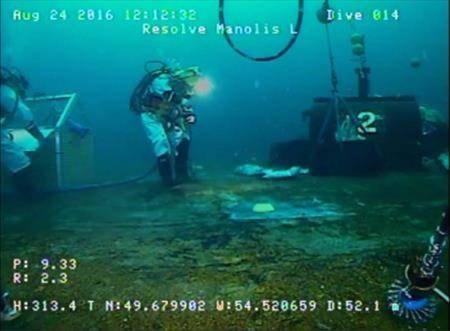TWILLINGATE, N.L. — More than three decades after the Manolis L sunk off Newfoundland’s picturesque Notre Dame Bay, the tricky task of extracting leaking bulk oil from the shipwreck has begun.
The paper carrier sank near Change Islands in 1985 in about 70 metres of water and was dormant until April 2013, when fuel oil leaked from cracks in the hull during a powerful storm.
The coast guard installed devices to plug leaks and catch oil, but small sheens in the water and oiled seabirds have been reported since 2013. Ottawa awarded a $15-million cleanup contract to Ardent Global this spring.
The vessel is too deep for divers to safely attach the removal equipment to the hull of the ship, so remotely operated underwater vehicles (ROVs) will be used to pinpoint the best location to magnetically attach the hoses for drilling and extraction.
“The way the world’s developing, the way we’re dealing with our own safety, and the way we’re dealing with these kinds of situations, it’s inevitable that because we can, we’re moving over to remote operated vehicles,” Ardent Global project manager Gordon Amos said during a technical briefing on Tuesday.
A 2016 technical assessment found there was 115 to 150 cubic metres of oil trapped in the wreck, along with about 60 cubic metres of diesel.
A ”pump and flush” system will push water down and pump oil to the surface.
The operation has its risks. Heating the oil is necessary to remove it from the ship, but risks of a spill are greater than during the initial assessment in 2016.
To deal with any potential accidents, response vessels will be on constant standby.
The response team includes the coast guard vessel Earl Grey, which will be stationed around-the-clock, and nine response vessels. The operation will be monitored by coast guard helicopters and a Transport Canada Dash 8 plane.
There are 140 personnel working on the site, and crews have been staging emergency response simulations to prepare for possible spills.
Anne Miller of the Canadian Coast Guard said Tuesday the team feels prepared to deal with a spill should anything go awry.
“A lot of work, a lot of thought, a lot of what-ifs, a lot of preparation have gone into this, so we’re ready,” Miller said.
Currently, the team is assessing the precise positioning of the ROVs before the removal commences. Once it begins, the operation will be ongoing all hours of the day, with work expected to conclude before the end of the summer.
Oil retrieved from the ship will be transported back to St. John’s for disposal, and the contaminated water flushed from the wreck will be processed and cleaned.
Carolyn Parsons and other members of the Manolis L Citizen’s Response Committee have been lobbying provincial and federal officials since the 2013 storm — writing letters, meeting with coast guard officials, and holding public events.
“We’re really excited to see this finally come to its conclusion,” Parsons said.
She said residents are happy to see the beginning of the end of lingering fears that a large oil leak could shut down the commercial fishery, or poison the natural environment that draws huge numbers of tourists.
